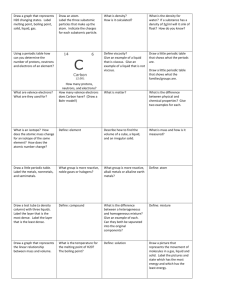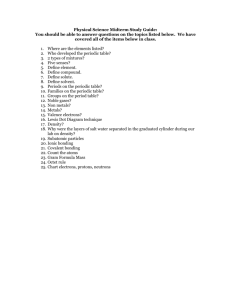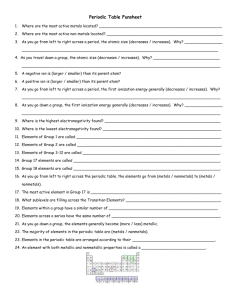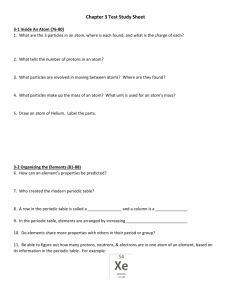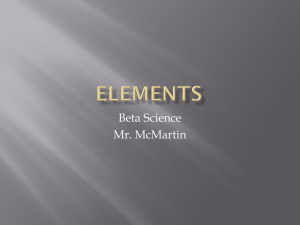Periods
advertisement
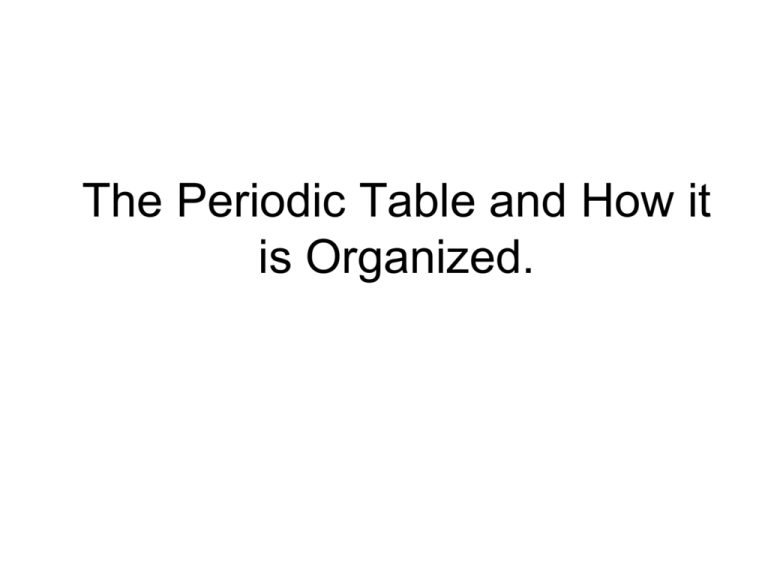
The Periodic Table and How it is Organized. Why is the Periodic Table important to me? • The periodic table is the most useful tool to a chemist. • It organizes lots of information about all the known elements. Pre-Periodic Table Chemistry … • …was a mess!!! • No organization of elements. • Imagine going to a grocery store with no organization!! • Difficult to find information. • Chemistry didn’t make sense. Dmitri Mendeleev: Father of the Table HOW HIS WORKED… • Put elements in rows by increasing atomic weight. • Put elements in columns by the way they reacted. SOME PROBLEMS… • He left blank spaces for what he said were undiscovered elements. (Turned out he was right!) • He broke the pattern of increasing atomic weight to keep similar reacting elements together. • http://en.wikipedia.org/wiki/Dmitri_Mendele ev The Current Periodic Table • Mendeleev wasn’t too far off. • Now the elements are put in rows by ATOMIC NUMBER!! increasing • The horizontal rows are called periods and are labeled from 1 to 7. • The vertical columns are called groups and are labeled from 1 to 18. Elements are arranged: Vertically into Groups Horizontally Into Periods Why? If you looked at one atom of every element in a group you would see… Each atom has the same number of electrons in it’s outermost shell. • An example… The group 2 atoms all have 2 electrons in their outer shells Be (Beryllium) Atom Mg (Magnesium) Atom • The number of outer or “valence” electrons in an atom effects the way an atom bonds. • The way an atom bonds determines many properties of the element. • This is why elements within a group usually have similar properties. If you looked at an atom from each element in a period you would see… Each atom has the same number of electron holding shells. An example… The period 4 atoms each have 4 electron containing shells or orbits. 4th Shell K (Potassium) Kr (Krypton) Atom Atom Fe (Iron) Atom Each group has distinct properties • The periodic Table is divided into several groups based on the properties of different atoms. • Use your blank periodic table to outline each group. • Write the title for each group. • Write the properties of each group within the outlined area of the group. Alkali Metals •Soft •Silvery colored •Metals •One valence electron •Very reactive!!! Alkali Metals reacting with water: • • • • • • Li (Lithium) Na (Sodium) K (Potassium) Rb (Rubidium) Cs (Cesium) Fr (Francium) Alkaline Earth Metals •Silvery-White Metals •Fairly reactive •Good Conductors of electricity •Two Valence Electrons •Many are found in rocks in the earth’s crust Transition Metals •Hard •Shiny •Good Conductors •Fairly Stable •Malleable (easily bent/hammered into wires or sheets) How many things can you think of that have Transition Metals in them? Other Metals (poor metals) •Ductile (can be pulled out into wire or thread shape), Malleable, Solids, • High Density •Opaque (not transparent) •Do not oxidize as transition metals do •They share properties with both metals and non-metals •Si (Silicon) and Ge (Germanium) are very important “semi-conductors” What are semiconductors used in? Nonmetals •Dull not shiny •Not malleable •Not ductile •Brittle as solids •Do not conduct electricity •Some are gases at room temp. •Metals and nonmetals form compounds where electrons move from the metal to the nonmetal Nonmetals What about Hydrogen?? •Simplest element with one electron and one proton •Makes up 90% of the universe •Chemical properties are different from any other group •Hydrogen sits atop the periodic table as an independent Halogens •Most are Poisonous •Seven valence electrons •Range from gases to liquids to solids at room temp. •Highly reactive especially with Alkali Metals and Alkaline Earth Metals Chlorine Gas was used as a chemical weapon during World War I. It was used by the Nazis in World War II. Yet when mixed with sodium, harmless table salt (NaCl) is the result Noble Gases •Unreactive •All present in Earth’s atmosphere in small amounts •Gases at room temperature •Used in Neon lights Jellyfish lamps made with noble gases artist- Eric Ehlenberger Colors Noble Gases produce in lamp tubes: • Ne (Neon): orange-red • Hg (Mercury): light blue • Ar (Argon): pale lavender • He (Helium): pale peach • Kr (Krypton): pale silver • Xe (Xenon): pale, deep blue Lanthanide Series •Soft •Malleable •Shiny •Very good conductors •Used in industry •Usually form hard to separate compounds Actinide Series •Only uranium and thorium are found on earth in significant amounts. •Elements after uranium are man made and very unstable
